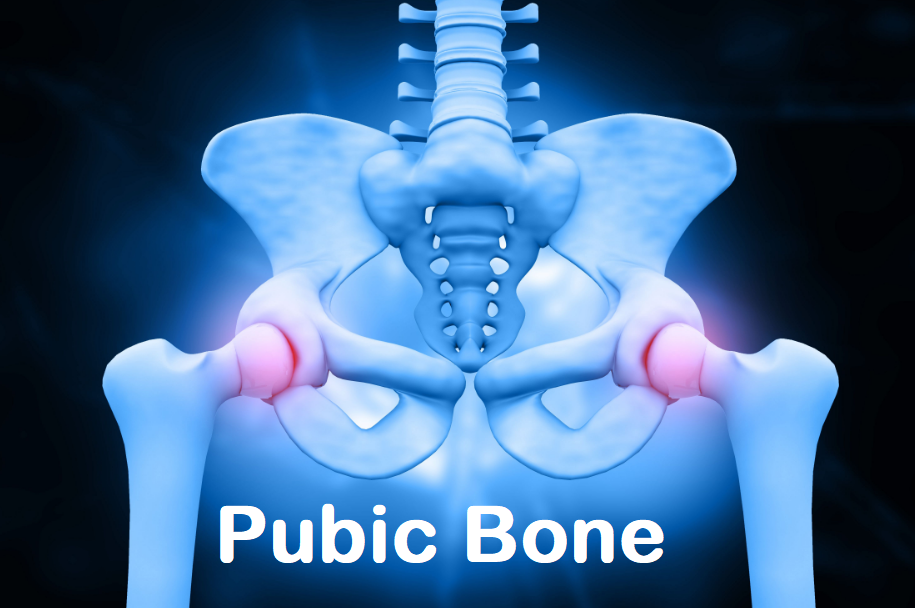The pubic bone is also often referred to as the furthest point. This huge bone backing the hip and lower pubic bone is one of the three principal bones that make up the pelvis. Otherwise called the pelvic support, the pelvis is a structure situated between the mid-region and thighs.
The pubic bone is the most front-oriented bone of all bones. Along with the ilium and ischium, the pubic bone helps structure the deep cup-shaped design of the pelvic support.
The fundamental purpose of the pubic bone is to safeguard the urinary organs (like the bladder and prostate) as well as for reproduction. The pubic bone contrasts in both structure and capacity in those conceived females versus those conceived males.

Table of Contents
Pubic Bone Functions
The principal function of the pubic bone is to protect the digestive tract, the bladder, and sexual organs.
The pubic bone joins the backbones of the pelvic support, holding them in place. This allows them to connect the upper portion of the body with the lower half of the body.
The pubic bone likewise has a few skeletal milestones that include muscles, ligaments, tendons, and ligaments. Every one of these designs considers the development of joints, bones, and real designs.
Conditions Affecting the Pubic Bone
There are a few circumstances that can affect the pubic bone, every one of which requires an alternate treatment and restoration plan.
Pubic Bone Fractures
Likewise, with any bone, the pubic bone can be broken. Whenever this happens, an individual cannot walk, sit, or move well without torment. Pelvic cracks are most commonly caused by high-impact events such as an auto collision or tumbling from a huge level.
When the pubic bone is broken, the bone should be immobilized to ensure a full recovery. Since the pubic bone is challenging to immobilize, complete bed rest for a long time is required. This prevents unnecessary development of the chest area and lower appendages.
Over-the-counter non-steroidal calming drugs (NSAIDs) like Aleve (naproxen) or Advil (ibuprofen) might be prescribed for pain relief and irritation. Certain individuals might require stronger narcotic medications.
After critical repairs have been made, bolsters or other assistive devices will be used as part of the restoration process. An experienced specialist will most likely be enlisted to coordinate the recovery plan.
The arrangement will most likely involve manual treatment to further develop muscle adaptability and increase flexibility in the hips, spine, and pelvis. Practices including the hips and center muscles are typically done following a pelvic crack.
Osteitis Pubic Bone
The pubic bone can also be affected by a condition called osteitis pubic bone. This is an aggravation of the pubic symphysis and associated tissues attached to the pubic bone.
Osteitis pubic bone is fundamentally brought about by monotonous pressure. It will in general influence competitors and others who are dynamic, including soccer players and marathon runners. It can also happen after labor or a pelvic medical procedure.
Side effects of osteitis pubic bone usually cause pain in the crotch or lower mid-region. There may likewise be agony and delicacy when strain is applied to the pubic bone. The condition can easily be confused with feminine issues or a pulled muscle.
Osteitis pubic bone is treated with rest. Notwithstanding over-the-counter NSAIDs, applying ice a few times every day for 10 to 15 minutes can ease the aggravation and torment.
The recovery from osteitis pubic bone includes activities to strengthen the muscles supporting the pubic bone. Exercises such as the center muscle preparation of the navigate muscular strength (which wraps across the gut like a belt) and abductor muscle conditioning exercises that target the inner thighs are also included.
FAQs
Pelvic torment can occur in all kinds of people and could originate from diseases, irregularities in the internal organs, or pain in the pubic bones. In females, pelvic pain may relate to the conceptive framework. Treatment relies on the reason.
Pubic bone: This part is at the front of the bone nearest to the privates. Ischium: Below the ilium and close to the pubic bone, this roundabout bone makes the lowermost part of the hip bone.
To ease the pain, apply an ice pack or a bundle of frozen vegetables enveloped by a dainty fabric to the joint. Do this for around 20 minutes each three to four hours. For additional help with discomfort, your primary care physician might suggest nonsteroidal calming drugs (NSAIDs), like ibuprofen (Advil) or naproxen (Aleve).
The piece of the pivotal skeleton directly connected to the pelvis is the lumbar spinal section. The femur is the affixed skeletal bone associated with the pelvis at the hip bone socket, a dense ring formed from the combination of three bones: the ilium, ischium, and pubic bone.
Final Words
The pubic bone is one of three significant bones that make up the pelvis. It interfaces the upper wing-molded bone (called the ileum) to the lower L-shape bone (called the ischium) to frame the pelvic support.
The essential purpose of the pubic bone is to help and safeguard the urinary and reproductive sexual organs. There is a right and left pubic bone connected by a piece of a ligament called the pubic symphysis.
The pubic bone is powerless against breaks, most commonly caused by high-impact wounds. Competitors may also trigger a condition called osteitis pubic bone in which the pubic bone becomes excited because of dull pressure. The two conditions that are treated by rest are often improved through treatment by a specialist.
